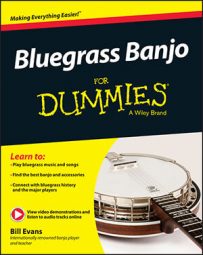Fourth- and first-string slides are a good addition to your bluegrass banjo technique. The fourth string is the lowest in pitch, as well as the heaviest and thickest of all your banjo strings. For these reasons, it’s the perfect string for playing booming, swooping slides that lend some heavyweight authority to your playing.
Fourth‐string slides are most often played up to the fifth‐fret G note, which is the same pitch as your open third string. Because many bluegrass songs (such as “Will the Circle Be Unbroken” and “Fireball Mail”) begin with a G note on the first main beat, it’s great to have a few sliding fourth‐string phrases ready to call up from memory as you kick off your next great bluegrass banjo solo.
Here’s a step‐by‐step guide to the most frequently played fourth‐string slide:
Fret the fourth string at the second fret with the middle finger of your fretting hand.
Pick the fourth string with your picking-hand thumb.
Slide the fretting finger up three frets, from the second to the fifth fret.
Because your fourth string is a heavier‐gauge string than your third string, don’t be surprised if it takes a little more pressure to get a great sound from your fourth string.
Keep the fretting pressure on to let the fifth-fret note ring.
Try playing this example to feel the power of the fourth‐string slide.

Playing fourth‐string slides with the forward roll
Banjo players use slides to embellish and draw attention to important melody notes. The fourth‐string slide to the fifth fret emphasizes the G note, and you can reinforce that melody note even further by including the G note in your roll patterns.

Playing “potatoes” using fourth‐string slides
Bluegrass musicians often kick off instrumentals with an introduction that communicates how fast the song is going to be played and lets the other players know that the tune is beginning. Musicians call these kickoff patterns “potatoes,” and they present the most frequently played banjo introductory lick, using a fourth‐string slide that travels from the fourth to the fifth frets.

Playing first‐string slides
Any slide that you play on the fourth string you can also play on the first string, because both strings are tuned to D pitches. “Cripple Creek” and “Fireball Mail” are just two banjo classics where you’ll need a first string, second‐ to fifth‐fret slide. Don’t forget to use the middle finger to pick the first string.


